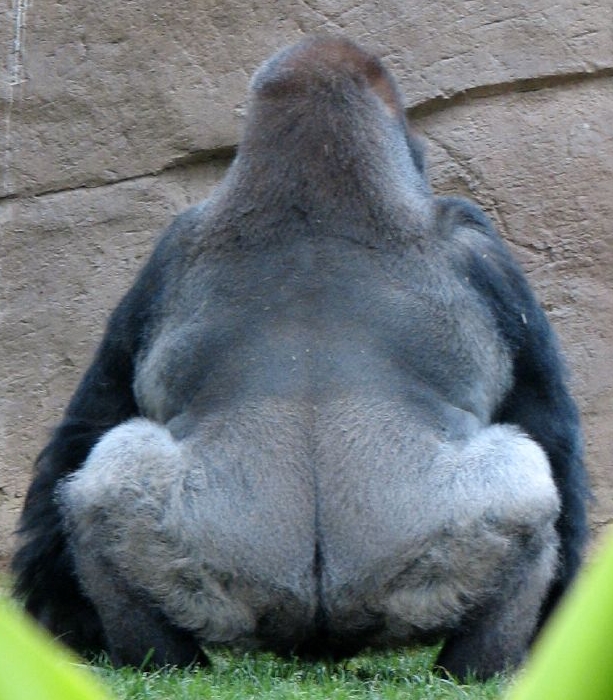Huge gluteous muscles gave humans bipedalism and uniquely big arses. And a need for post-crap after-care. Fri 13 May 2022

Despite being furry, gorilla bums don't need wiping. Source
Standing on their own two feet required development of a radically different muscular structure compared to other primates. But the development of huge muscles on both sides of the human anus up-sized our risk of self-soiling. In response, humans developed additional inspection and grooming behaviours:
Intricate self-grooming is made possible by the radical re-working of spine, hip and pelvis that enables bipedalism. Source: NY Post
Human spines and pelvises are unlike those of primates and pigs. The following list is from Eugene McCarthy's MacroEvolution:
- Short, dorsal spines on first six cervical vertebra
- Seventh cervical vertebrae:
- long dorsal spine
- transverse foramens
- Fewer floating and more non-floating ribs
- More lumbar vertebrae
- Fewer sacral vertebrae
- More coccygeal vertebrae (long “tail bone”)
- Centralized spine
- Short pelvis relative to body length
- Sides of pelvis turn forward
- Sharp lumbo-sacral promontory
- Large arse (Massive gluteal muscles)
Why?
Because being designed as a bipedal load-carrier (a mandroid that originally seems to have been called a 'Jack') required more and bigger muscles attached to a more complex pelvis. Which forces those muscles to the rear.
Creating the mystery of the human bottom.
It took humans from this:
Obviously, this is disrespectful to the pig. Source
to this:
Human female demonstrates human gluteal muscle size and mobility. Source: Pornkai
Seriously.
If evolution had designed this, why do humans still need to be shown how to lift things?
Source: How To Bend Forward Properly | How to Lift Things Well | Healthy Manual Handling Techniques
Back problems suggest humans haven't learned how to use their bum and back muscle structure because this muscle structure is new. Human understanding of their gluteus muscles is a pile of shit.
And the confusion doesn't end with bad backs and the toilet paper industry:
It's a Lincolnshire thing. Source: Quantum Leap
Seriously.
Why do you think churches, and later schools, introduced - of all things - sex education?
For the technical compromises involved in these modifications, see How did human butts evolve to look that way?.
I should point out, in the interests of fairness and honesty, that some hagiographers of hybrid DNA think the engineering went the other way: that pigs were bio-engineered from human DNA. They cite Greek mythology. Such as the encounter with Circes in Odysseus:
Downgrades are a pig. Source: PIGSAREHUMANS / Human Meat Markets / Tainting Ancient and MODERN Civilizations
A more recent version of the same belief claims edible hybrids were introduced to clean up the catering industry. In much the same same way fish-on-Fridays was introduced to help diminish catering's dependence on cannibalism. This claim artfully presents Reality as a joke:
Source: Meet the meat!
Continuing the list of things that make humans different to their closest relatives:
- Curved sacrum with short dorsal spines
- Hind limbs longer than forelimbs
- Femur:
- Condyles equal in size
- Knock-kneed
- Elliptical condyles
- Deep intercondylar notch at lower end of femur
- Deep patellar groove with high lateral lip
- Crescent-shaped lateral meniscus with two tibial insertions
- Short malleolus medialis
- Talus suited strictly for extension and flexion of the foot
- Long calcaneus relative to foot (metatarsal) length
- Short digits (relative to chimpanzee)
- Terminal phalanges blunt (ungual tuberosities)
- Narrow pelvic outlet
More:
Your bum and back really are a beautiful complex of muscles. Treat them well:
Source: How To Bend Forward Properly | How to Lift Things Well | Healthy Manual Handling Techniques
© All rights reserved. The original author retains ownership and rights.
More of this investigation:
You're Not Real Are You?